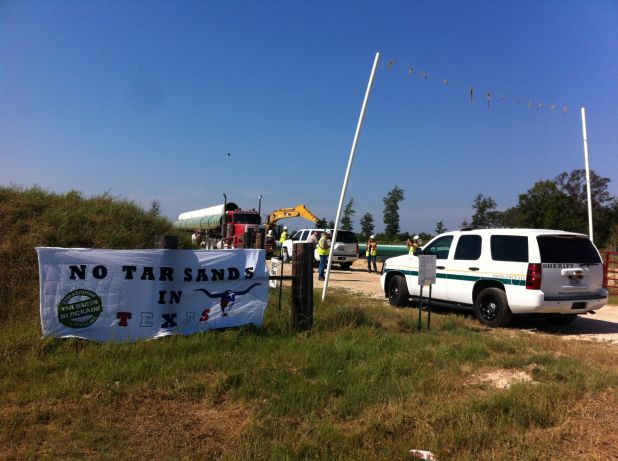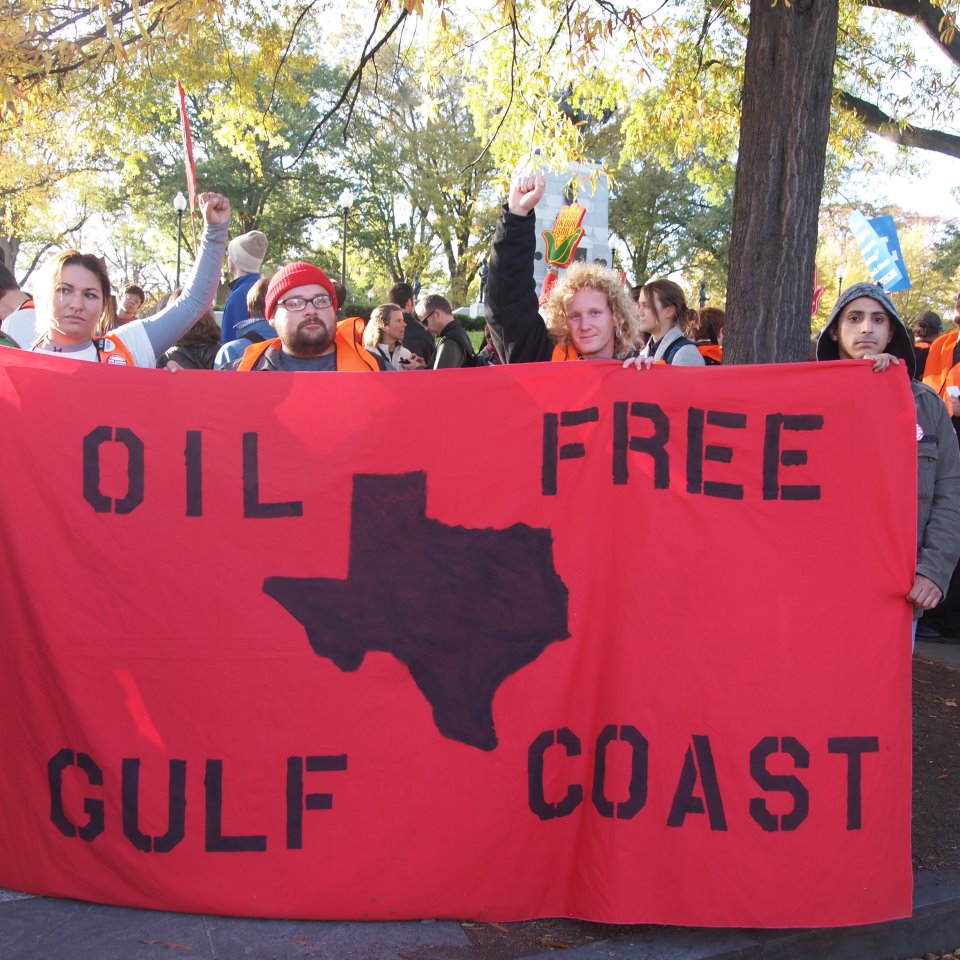
by Deep Green Resistance News Service | Aug 28, 2012 | Obstruction & Occupation
By Tar Sands Blockade
Just minutes ago four landowner advocates and climate justice organizers locked themselves to the underside of a massive truck carrying 36″ pipe intended for Keystone XL construction. The truck is parked, idled at the entrance of the pipeyard, rendering construction activity impossible. Seven blockaders total are onsite risking arrest. Blockaders from the Red River valley to the Gulf Coast and beyond have united to realize their collective vision of a world without toxic tar sands pipelines. Today’s message is clear: the people are rising up to defend their homes.
This act of peaceful civil disobedience comes in the wake of a recent court decision condoning TransCanada’s use of eminent domain for private gain. Last week Lamar County Judge Bill Harris ruled in a shockingly abbreviated fifteen-word summary judgment that Texas farmer Julia Trigg Crawford cannot challenge TransCanada’s claim that it is entitled to a piece of her home. The underwhelming ruling was emailed to Ms. Crawford’s attorney late in the evening of August 15 from the Judge’s iPhone.
The arrogant disregard levied at landowners like Julia Trigg Crawford for simply not consenting to have a tar sands pipeline permanently bisect their homes is what motivated Houston businessman Ray Torgerson to take action with the Blockade. “The fact that this corporation can check a box on a form and steal someone’s land is insulting,” Ray says. “We are here to defend our homes and stand with landowners like Julia.”
Further emblematic of the disrespect small town families like the Crawfords have faced throughout Keystone XL legal proceedings, Ms. Crawford received first notice of the ruling from a reporter seeking comment who had been blind carbon copied on the County Judge’s email ruling.
“It was heartbreaking to hear a generational family farm like the Crawford’s can be taken away by a multinational corporation,” exclaims blockader Audrey Steiner, a linguistic anthropologist from Austin. “I’m here to change the direction our country is taking.”
The concerns of the blockaders today go well beyond TransCanada’s appalling contempt for property rights. As Tammie Carson, a lifelong Texan living in Arlington explains, “I’m doing this for my grandchildren. I’m outraged that multinational corporations like TransCanada are wrecking our climate. The planet isn’t theirs to destroy, and I’m willing to take a risk to protect my grandchildren’s future.”
Denny Hook, a retired minister from Gainesville, Texas, describes himself as “An environmentalist that happens to be a minister.” In taking action today, Hook hopes to inspire more people to join the movement. “Things are so dire that if all of us don’t rise up we won’t make it. This pipeline is the difference between Earth on the edge and Earth over the edge.”
Tar Sands Blockade is a coalition of Texas and Oklahoma landowners and climate organizers using peaceful and sustained civil disobedience to stop the construction of Keystone XL.
“The blockade is an expression of people who have spent years using every available avenue afforded to them, and nothing has worked,” explains Tar Sands Blockade spokesperson Ron Seifert. “The urgency of this crisis is galvanizing supporters who understand that doing nothing involves a greater risk than taking action.”
From Tar Sands Blockade: http://tarsandsblockade.org/press/press-releases/
by Deep Green Resistance News Service | Jul 22, 2012 | Toxification
By Environment News Service
Flares, leaking pipelines and tanks emitted 92,000 tons of toxic chemicals into the air during accidents, break-downs and maintenance at Texas oil and gas facilities, refineries and petrochemical plants over the past three years, finds a report released today by the nonprofit Environmental Integrity Project, EIP.
Based on data from the Texas Commission on Environmental Quality, a state agency, the EIP report shows that, in addition to the emissions from normal operations, more than 42,000 tons of sulfur dioxide, and just over 50,000 tons of smog-forming volatile organic compounds were released from 2009 through 2011. The report shows a “pattern of neglect” as the pollution from these events drags on for weeks or months.
Community groups, including the EIP, notified the U.S. Environmental Protection Agency today that they will take the agency to court if it fails to crack down on this toxic pollution.
Hilton Kelley, executive director of Communities In-power and Development in Port Arthur, Texas, sees the health effects of these emissions every day. “The EPA knows there are a disproprortionate number of people living with respiratory, cancer, liver and kidney disease directly related to what they’re being exposed to,” he told reporters on a conference call today.
“Within Port Arthur I personally know at least 12 people who have recently died from cancer and one young lady who died from an asthma attack,” said Kelley. “The Environmental Protection Agency must do a better job of counting the toxic pollution dumped into low-income and minority communities.”
In Houston, Juan Parras, founder of Texas Environmental Justice Advocacy Services, said, “I am a firm believer and advocate for clean air, however, I live in an environment where ‘clean’ is dictated by petrochemical, gas plants, and oil refineries in the Houston Region. They decide what they can get away with and blame their highly toxic emissions on ‘accidents’ that they claim are beyond their control.”
While both sulfur dioxide and volatile organic compounds, VOCs, are linked to asthma attacks and other respiratory ailments, and can contribute to premature death from heart disease, because they result from these so-called “emission events,” they are usually not included in the data the government uses to establish regulations or evaluate public health impacts.
Natural gas operations, including well heads, pipelines, compressors, boosters, and storage systems, accounted for more than 85 percent of total sulfur dioxide and nearly 80 percent of the VOCs released during these emission events, the Environmental Integrity Project report shows.
The Clean Air Act makes polluters strictly liable for their mistakes, but loopholes in regulations either excuse violations that result from malfunctions altogether, or allow polluters to escape penalties by claiming that such mishaps are beyond the control of plant operators. As a result, federal or state agencies rarely even investigate these events, much less take enforcement action.
Read more from Environment News Service: http://www.ens-newswire.com/ens/jul2012/2012-07-18-01.html

by Deep Green Resistance News Service | Jun 26, 2012 | Climate Change, Obstruction & Occupation
By Candice Bernd / TruthOut
The deadline for the review of TransCanada’s permits for the Gulf Coast portion of the Keystone XL pipeline was Monday, June 25, 2012. At the Texas Army Corp of Engineers Galveston office and without any finalization of review, those permits will be automatically granted to the corporation – thanks to President Obama’s announcement that he would expedite the southern leg of the pipeline in Cushing, Oklahoma, back in March.
That’s why Texas climate justice activists, including myself, are officially announcing the Tar Sands Blockade, an epic action that we have been organizing since the beginning of the year. We’re mostly associated with Rising Tide North Texas, and we’re 100 percent prepared to use nonviolent, direct action to block the pipeline’s construction to protect our home.
Bring it, TransCanada
The Tar Sands Blockade will be coordinating nonviolent, direct actions along the pipeline route to stop this zombie pipeline once and for all. We are working with national allies as well as local communities to coordinate a road show that will travel throughout Texas and Oklahoma as well as a regional training effort for activists interested in getting involved in the blockade movement against the Keystone XL.
“Our action is giving a new meaning to ‘Don’t Mess with Texas,'” said Tar Sands Blockade Collective member Benjamin Kessler. Kessler is also a member of Iraq Veterans Against the War.
The permits for the pipeline’s construction are being automatically granted under the Nationwide Permit 12 protocol, or NWP 12. The permits do not need an environmental impact statement to accompany them, according to this process. That very fact alone endangers more than 631 streams and wetlands that the pipeline will cross in our state. Not only that, but the entire Carrizo-Wilcox Aquifer, which supplies drinking water for ten to 12 million homes across 60 counties in East Texas, along the pipeline’s path, is threatened with contamination.
The Keystone XL remains key to the expansion of the Alberta tar sands and leading NASA climate scientist James Hansen has called the pipeline “a fuse to the largest carbon bomb on the planet.” According to Hansen, if the carbon stored in the tar sands is released into the atmosphere, it would mean “game over for the climate.”
350.org founder Bill McKibben has worked hard to get Hansen’s message out to the public and to lawmakers in Washington. After more than 1,200 were arrested during the onset of the Tar Sands Action last fall, another 12,000 turned out to surround the White House to tell President Obama that the Keystone XL is not in the nation’s best interest.
McKibben was elated to hear that the Tar Sands Blockade is continuing to foster the spirit of resistance against the pipeline in the South with the use of nonviolent, direct action.
“Let’s be clear what the drama is here: human bodies and spirits up against the unlimited cash and political influence of the fossil fuel industry. We all should be grateful for this peaceful witness,” McKibben said.
Landowners living along the pipeline’s path say they have been intimidated by TransCanada to sign away the rights to their land, and it’s not just landowners that will lose. The pipeline is expected to destroy indigenous archeological and historical sites – including grave sites – in Oklahoma and Texas.
Read more from TruthOut: http://truth-out.org/news/item/9997-its-time-for-a-texas-tar-sands-blockade

by Deep Green Resistance News Service | Apr 30, 2012 | Climate Change, NEWS
By Louise Gray / The Telegraph
Usually at night the air closer to the ground becomes colder when the sun goes down and the earth cools.
But on huge wind farms the motion of the turbines mixes the air higher in the atmosphere that is warmer, pushing up the overall temperature.
Satellite data over a large area in Texas, that is now covered by four of the world’s largest wind farms, found that over a decade the local temperature went up by almost 1C as more turbines are built.
This could have long term effects on wildlife living in the immediate areas of larger wind farms.
It could also affect regional weather patterns as warmer areas affect the formation of cloud and even wind speeds.
It is reported China is now erecting 36 wind turbines every day and Texas is the largest producer of wind power in the US.
Liming Zhou, Research Associate Professor at the Department of Atmospheric and Environmental Sciences at the University of New York, who led the study, said further research is needed into the affect of the new technology on the wider environment.
“Wind energy is among the world’s fastest growing sources of energy. The US wind industry has experienced a remarkably rapid expansion of capacity in recent years,” he said. “While converting wind’s kinetic energy into electricity, wind turbines modify surface-atmosphere exchanges and transfer of energy, momentum, mass and moisture within the atmosphere. These changes, if spatially large enough, might have noticeable impacts on local to regional weather and climate.”
The study, published in Nature, found a “significant warming trend” of up to 0.72C (1.37F) per decade, particularly at night-time, over wind farms relative to near-by non-wind-farm regions.
The team studied satellite data showing land surface temperature in west-central Texas.
“The spatial pattern of the warming resembles the geographic distribution of wind turbines and the year-to-year land surface temperature over wind farms shows a persistent upward trend from 2003 to 2011, consistent with the increasing number of operational wind turbines with time,” said Prof Zhou.
However Prof Zhou pointed out the most extreme changes were just at night and the overall changes may be smaller.
Also, it is much smaller than the estimated change caused by other factors such as man made global warming.
“Overall, the warming effect reported in this study is local and is small compared to the strong background year-to-year land surface temperature changes,” he added.
The study read: “Despite debates regarding the possible impacts of wind farms on regional to global scale weather and climate, modelling studies agree that they can significantly affect local scale meteorology.”
Professor Steven Sherwood, co-Director of the Climate Change Research Centre at the University of New South Wales, said the research was ‘pretty solid’.
“This makes sense, since at night the ground becomes much cooler than the air just a few hundred meters above the surface, and the wind farms generate gentle turbulence near the ground that causes these to mix together, thus the ground doesn’t get quite as cool. This same strategy is commonly used by fruit growers (who fly helicopters over the orchards rather than windmills) to combat early morning frosts.”
From The Telegraph: http://www.telegraph.co.uk/earth/earthnews/9234715/Wind-farms-can-cause-climate-change-finds-new-study.html
Photo by Thomas Richter on Unsplash
by Deep Green Resistance News Service | Apr 24, 2012 | Mining & Drilling, Toxification
By Earthworks
Today Colleyville and Southlake residents, and Earthworks’ Oil & Gas Accountability Project released results from local residents’ privately-funded air testing of Titan Operations’ “mini-frack” on the border of both communities. The tests, performed by GD Air Testing Inc. of Richardson, TX, prove emissions released during fracking and flowback contain dangerous levels of toxic chemicals.
“We paid for tests because we can’t depend on the city or the fracking industry,” said Colleyville resident Kim Davis. She continued, “The tests confirmed our worst fears, while Colleyville ignored their own tests to let fracking continue. Apparently the city represents Titan and the gas industry instead of local residents.”
Colleyville City ordinances expressly prohibit the release of any gases: “No person shall allow, cause or permit gases to be vented into the atmosphere or to be burned by open flame.”
The community-funded test results, which detected twenty-six chemicals, also showed carbon disulfide, a neurotoxin at twice the state level for short-term exposure. Benzene, a known carcinogen, and Naphthalene, a suspected carcinogen, were both over state long-term exposure levels by more than 9 times and more than 7 times, respectively. Carbonyl sulfide, dimethyl disulfide and Pyridine were all detected above safe limits for long-term exposure.
Gordon Aalund, an MD with toxicology training who lives in Southlake and practices emergency medicine said, “Exceeding long and short term exposure limits to these toxics places us all at increased and unneeded risk.” He went on to say, “When your government fails to protect you and the company cannot be trusted, private citizens are forced to act.”
The Colleyville results indirectly confirm the suspicions of Arlington-area residents about air pollution from ongoing Chesapeake Energy fracking and flowback operations in their neighborhood since December 2011. Residents who experienced health impacts were told by Chesapeake that flowback emissions were only “steam”. When challenged to substantiate its claims with public testing, the company failed to respond.
“It’s great that concerned citizens in the Colleyville-area have the wherewithal to pay for their own testing when government fails to do its job. But I live in southeast Arlington, where our community doesn’t have the resources to do government’s job for it,” said Arlington resident Chuck Harper. He continued, “Why isn’t TCEQ doing these tests? If the watchdog isn’t watching, who do we turn to for protection?”
“It’s state and local failures like these that make plain the need to close fracking loopholes in federal environmental laws,” said Earthworks’ Oil & Gas Accountability Project organizer Sharon Wilson. She continued, “When TCEQ can’t be bothered to protect their own citizens, when cities ignore their own laws, when companies lie to communities left, right and center, there’s nowhere else to turn.”
From Earthworks: http://www.earthworksaction.org/media/detail/independent_test_results_show_fracking_flowback_emissions_are_dangerous_tox#When:13:16:19Z



